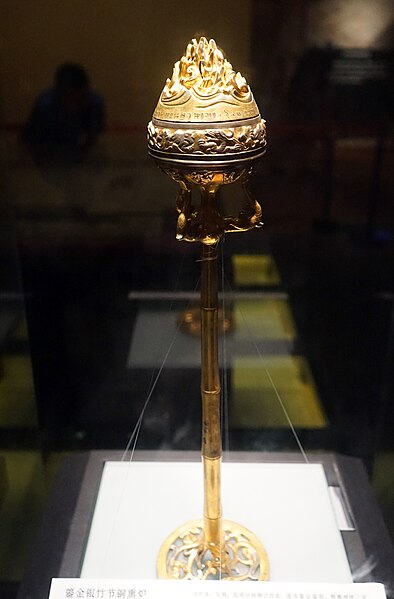Wei Qing, courtesy name Zhongqing, born Zheng Qing in Linfen, Shanxi, was a Chinese military general and politician of the Western Han dynasty who was acclaimed for his campaigns against the Xiongnu, and his rags to riches life. He was a consort kin of Emperor Wu of Han as the younger half-brother of Emperor Wu's wife Empress Wei Zifu, and later the third husband of Emperor Wu's older sister Eldest Princess Yangxin. He was also the maternal uncle of Huo Qubing, another decorated Han general who participated in the war against the Xiongnu.
A gold-plated hill censer in Shaanxi History Museum. The inscriptions on it suggest that it was collected by Emperor Wu, later was bestowed to Wei Qing's wife, Eldest Princess Yangxin.
Tomb of Wei Qing (34°20′30″N 108°34′49″E / 34.341728°N 108.580145°E / 34.341728; 108.580145), seen from the tomb of Huo Qubing. Maoling, Xingping, Shaanxi.
The Han dynasty was an imperial dynasty of China, established by Liu Bang and ruled by the House of Liu. The dynasty was preceded by the short-lived Qin dynasty (221–206 BC) and a warring interregnum known as the Chu–Han contention (206–202 BC), and it was succeeded by the Three Kingdoms period (220–280 AD). The dynasty was briefly interrupted by the Xin dynasty (9–23 AD) established by the usurping regent Wang Mang, and is thus separated into two periods—the Western Han and the Eastern Han (25–220 AD). Spanning over four centuries, the Han dynasty is considered a golden age in Chinese history, and had a permanent impact on Chinese identity in later periods. The majority ethnic group of modern China refer to themselves as the "Han people" or "Han Chinese". The spoken Sinitic language and written Chinese are referred to respectively as the "Han language" and "Han characters".
Western Han painted ceramic jar with raised reliefs of dragons, phoenixes, and taotie
Reverse side of a Western Han bronze mirror with a painted flower motif
Statue of a horse trampling a Xiongnu warrior, at the mausoleum of Western Han general Huo Qubing (d. 117 BC), who fought in the Han–Xiongnu War. This is the first known monumental stone statue in China.
The ruins of a Han-dynasty watchtower made of rammed earth at Dunhuang, located at the eastern edge of the Silk Road






